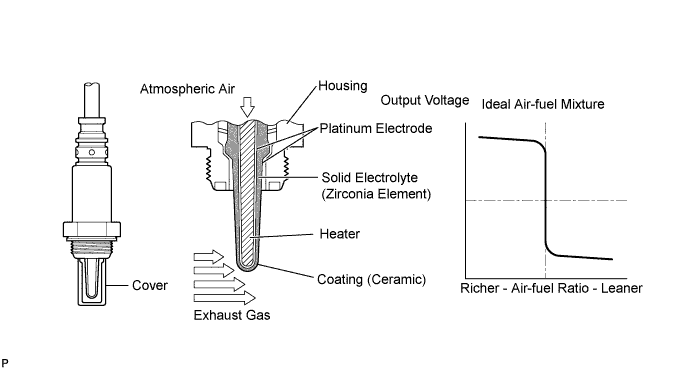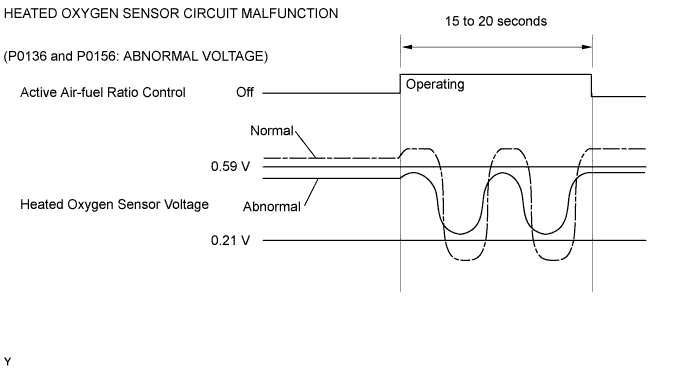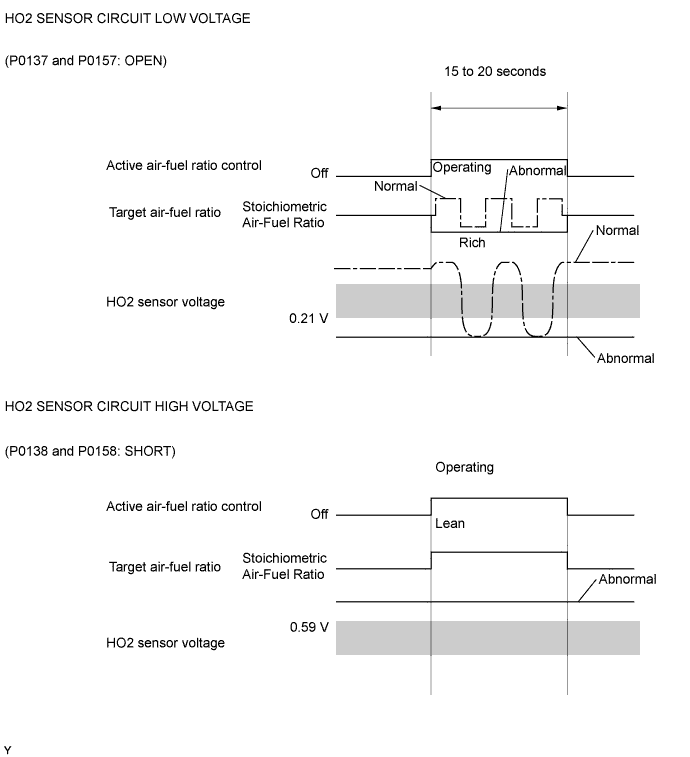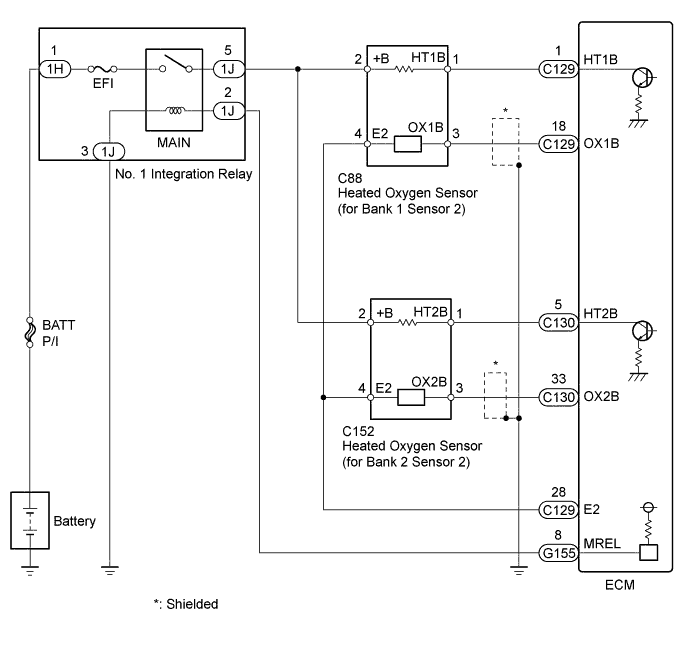READ OUTPUT DTC (DTC P0136, P0137, P0138, P0156, P0157 OR P0158)
READ VALUE USING INTELLIGENT TESTER (OUTPUT VOLTAGE OF HEATED OXYGEN SENSOR)
INSPECT HEATED OXYGEN SENSOR (CHECK FOR SHORT)
CHECK HARNESS AND CONNECTOR (CHECK FOR SHORT)
PERFORM ACTIVE TEST USING INTELLIGENT TESTER (CONTROL THE INJECTION VOLUME)
PERFORM ACTIVE TEST USING INTELLIGENT TESTER (CONTROL THE INJECTION VOLUME)
PERFORM ACTIVE TEST USING INTELLIGENT TESTER (CONTROL THE INJECTION VOLUME)
INSPECT HEATED OXYGEN SENSOR (HEATER RESISTANCE)
CHECK HARNESS AND CONNECTOR (HEATED OXYGEN SENSOR - ECM)
PERFORM CONFIRMATION DRIVING PATTERN
CHECK WHETHER DTC OUTPUT RECURS (DTC P0136, P0137, P0138, P0156, P0157 OR P0158)
PERFORM CONFIRMATION DRIVING PATTERN
CHECK WHETHER DTC OUTPUT RECURS (DTC P0136, P0137, P0138, P0156, P0157 OR P0158)
DTC P0136 Oxygen Sensor Circuit Malfunction (Bank 1 Sensor 2) |
DTC P0137 Oxygen Sensor Circuit Low Voltage (Bank 1 Sensor 2) |
DTC P0138 Oxygen Sensor Circuit High Voltage (Bank 1 Sensor 2) |
DTC P0156 Oxygen Sensor Circuit Malfunction (Bank 2 Sensor 2) |
DTC P0157 Oxygen Sensor Circuit Low Voltage (Bank 2 Sensor 2) |
DTC P0158 Oxygen Sensor Circuit High Voltage (Bank 2 Sensor 2) |
DESCRIPTION
A three-way catalytic converter is used in order to convert the carbon monoxide, hydrocarbons, and nitrogen oxide into less harmful substances. To allow the three-way catalytic converter to function effectively, it is necessary to keep the air fuel ratio of the engine near the stoichiometric air fuel ratio. For the purpose of helping the ECM to deliver accurate air fuel ratio control, a heated oxygen sensor is used.The heated oxygen sensor is located behind the three-way catalytic converter, and detects the oxygen concentration in the exhaust gas. Since the sensor is integrated with the heater that heats the sensing portion, it is possible to detect the oxygen concentration even when the intake air volume is low (the exhaust gas temperature is low).
When the air fuel ratio becomes lean, the oxygen concentration in the exhaust gas is rich. The heated oxygen sensor informs the ECM that the post-three-way catalytic converter air fuel ratio is lean (low voltage, i.e. below 0.45 V).
Conversely, when the air fuel ratio is richer than the stoichiometric air fuel level, the oxygen concentration in the exhaust gas becomes lean. The heated oxygen sensor informs the ECM that the post-three-way catalytic converter air fuel ratio is rich (high voltage, i.e. higher than 0.45 V). The heated oxygen sensor has the property of changing its output voltage drastically when the air fuel ratio is close to the stoichiometric level.
The ECM uses the supplementary information from the heated oxygen sensor to determine whether the air fuel ratio after the three-way catalytic converter is rich or lean, and adjusts the fuel injection time accordingly. Thus, if the heated oxygen sensor is working improperly due to internal malfunctions, the ECM is unable to compensate for deviations in the primary air fuel ratio control.

| DTC Code | DTC Detection Condition | Trouble Area |
| P0136 P0156 |
|
|
| P0137 P0157 |
|
|
| P0138 P0158 |
|
|
MONITOR DESCRIPTION
- Active Air-Fuel Ratio Control
The ECM usually performs air-fuel ratio feedback control so that the air fuel ratio sensor output indicates a near stoichiometric air-fuel ratio. This vehicle includes active air-fuel ratio control in addition to regular air-fuel ratio control. The ECM performs active air-fuel ratio control to detect any deterioration in the three-way catalytic converter and heated oxygen sensor malfunctions (refer to the diagram below).
Active air-fuel ratio control is performed for approximately 15 to 20 seconds while driving with a warm engine. During active air-fuel ratio control, the air-fuel ratio is forcibly regulated to become lean or rich by the ECM. If the ECM detects a malfunction, a DTC is stored.
- Abnormal Voltage Output of HO2 Sensor (DTC P0136 and P0156)
While the ECM is performing active air-fuel ratio control, the air-fuel ratio is forcibly regulated to become rich or lean. If the sensor is not functioning properly, the voltage output variation is small. For example, when the HO2 sensor voltage does not decrease to below 0.21 V and does not increase to higher than 0.59 V during active air-fuel ratio control, the ECM determines that the sensor voltage output is abnormal and stores DTC P0136 or P0156.
- Open or Short in Heated Oxygen (HO2) Sensor Circuit (DTC P0137 and P0157 or P0138 and P0158)
During active air-fuel ratio control, the ECM calculates the Oxygen Storage Capacity (OSC)* of the three-way catalytic converter by forcibly regulating the air-fuel ratio to become rich or lean. If the heated oxygen sensor has an open or short, or the voltage output of the sensor decreases significantly, the OSC indicates an extraordinarily high value. Even if the ECM attempts to continue regulating the air-fuel ratio to become rich or lean, the heated oxygen sensor output does not change.
While performing active air-fuel ratio control, when the target air-fuel ratio is rich and the heated oxygen sensor voltage output is below 0.21 V (lean), the ECM interprets this as an abnormally low sensor output voltage and stores DTC P0137 or P0157. When the target air-fuel ratio is lean and the voltage output is higher than 0.59 V (rich) during active air-fuel ratio control, the ECM determines that the sensor voltage output is abnormally high, and stores DTC P0138 or P0158.- HINT:
- The three-way catalytic converter has the capability to store oxygen. The OSC and the emission purification capacity of the three-way catalytic converter are mutually related. The ECM determines whether the catalyst has deteriorated based on the calculated OSC value.

During normal air-fuel ratio feedback control, there are small variations in the exhaust gas oxygen concentration. In order to continuously monitor the slight variations in the heated oxygen sensor signal while the engine is running, the impedance* of the sensor is measured by the ECM. The ECM determines that there is a malfunction in the sensor when the measured impedance deviates from the standard range.
*: The effective resistance in an alternating current electrical circuit.- HINT:
- The impedance cannot be measured using an ohmmeter.
- DTC P0136 and P0156 indicate the deterioration of the heated oxygen sensor. The ECM stores this DTC by calculating the impedance of the sensor when the typical enabling conditions are satisfied (2 driving cycles).
- DTC P0137 and P0157 indicate an open or short circuit in the heated oxygen sensor (2 driving cycles). The ECM stores this DTC when the impedance of the sensor exceeds the threshold of 15 kΩ.
WIRING DIAGRAM

CONFIRMATION DRIVING PATTERN

- Connect the intelligent tester to the DLC3.
- Turn the ignition switch to ON and turn the tester on.
- Clear the DTCs (even if no DTCs are stored, perform the clear DTC operation).
- Turn the ignition switch off and wait for at least 30 seconds.
- Turn the ignition switch to ON and turn the tester on [A].
- Start the engine and warm it up until the engine coolant temperature reaches 75°C (167°F) or higher [B].
- With the transmission in 5th gear or higher, drive the vehicle at a speed between 60 and 100 km/h (37 and 63 mph) for 10 minutes or more [C].
- CAUTION:
- When performing the confirmation driving pattern, obey all speed limits and traffic laws.
- Enter the following menus: Powertrain / Engine / DTC [D].
- Read the pending DTCs.
- HINT:
- If a pending DTC is output, the system is malfunctioning.
- If a pending DTC is not output, perform the following procedure.
- Enter the following menus: Powertrain / Engine / Utility / All Readiness.
- Input the DTC: P0136, P0137, P0138, P0156, P0157 or P0158.
- Check the DTC judgment result.
Tester Display Description NORMAL - DTC judgment completed
- System normal
ABNORMAL - DTC judgment completed
- System abnormal
INCOMPLETE - DTC judgment not completed
- Perform driving pattern after confirming DTC enabling conditions
N/A - Unable to perform DTC judgment
- Number of DTCs which do not fulfill DTC preconditions has reached ECU memory limit
- HINT:
- If the judgment result shows NORMAL, the system is normal.
- If the judgment result shows ABNORMAL, the system has a malfunction.
- If the judgment result shows INCOMPLETE or N/A, perform steps [C] through [D].
- DTC judgment completed
INSPECTION PROCEDURE
- HINT:
- Malfunctioning areas can be identified by performing the Control the Injection Volume function provided in the Active Test. The Control the Injection Volume function can help to determine whether the air fuel ratio sensor, heated oxygen sensor and other potential trouble areas are malfunctioning.
- The following instructions describe how to conduct the Control the Injection Volume operation using the intelligent tester.
- Connect the intelligent tester to the DLC3.
- Start the engine and turn the tester on.
- Warm up the engine and run the engine at an engine speed of 2500 rpm for approximately 90 seconds.
- Enter the following menus: Powertrain / Engine and ECT / Active Test / Control the Injection Volume.
- Perform the Active Test operation with the engine idling.
- Monitor the output voltages of the air fuel ratio and heated oxygen sensors (AFS Voltage B1S1 and O2S B1S2 or AFS Voltage B2S1 and O2S B2S2) displayed on the tester.
- HINT:
- Change the fuel injection volume within the range of -12.5% to +12.5%. The injection volume can be changed in fine gradations.
- Each sensor reacts in accordance with increases and decreases in the fuel injection volume.
| Tester Display (Sensor) | Injection Volume | Status | Voltage |
| AFS Voltage B1S1 or AFS Voltage B2S1 (Air fuel ratio) | +12.5% | Rich | Below 3.1 V |
| AFS Voltage B1S1 or AFS Voltage B2S1 (Air fuel ratio) | -12.5% | Lean | Higher than 3.4 V |
| O2S B1S2 or O2S B2S2 (Heated oxygen) | +12.5% | Rich | Higher than 0.55 V |
| O2S B1S2 or O2S B2S2 (Heated oxygen) | -12.5% | Lean | Below 0.4 V |
- NOTICE:
- The air fuel ratio sensor has an output delay of a few seconds and the heated oxygen sensor has a maximum output delay of approximately 20 seconds.
| Case | Air Fuel Ratio Sensor (Sensor 1) Output Voltage | Heated Oxygen Sensor (Sensor 2) Output Voltage | Trouble Area |
| 1 |   |   | - |
| 2 |   |   |
|
| 3 |   |   |
|
| 4 |   |   |
|
- Following the Control the Injection Volume procedure enables technicians to check and graph the voltage outputs of both the air fuel ratio and heated oxygen sensors.
- To display the graph, enter the following menus: Powertrain / Engine and ECT / Active Test / Control the Injection Volume / All Data / AFS Voltage B1S1 and O2S B1S2 or AFS Voltage B2S1 and O2S B2S2; then press the view button.
- NOTICE:
- Inspect the fuses for circuits related to this system before performing the following inspection procedure.
- HINT:
- Read freeze frame data using the intelligent tester. Freeze frame data records the engine condition when malfunctions are detected. When troubleshooting, freeze frame data can help determine if the vehicle was moving or stationary, if the engine was warmed up or not, if the air fuel ratio was lean or rich, and other data from the time the malfunction occurred.
- Bank 1 refers to the bank that includes No. 1 cylinder*.
*: The No. 1 cylinder is the cylinder which is farthest from the transmission. - Bank 2 refers to the bank that does not include No. 1 cylinder.
- Sensor 1 refers to the sensor closest to the engine assembly.
- Sensor 2 refers to the sensor farthest away from the engine assembly.
| 1.READ OUTPUT DTC (DTC P0136, P0137, P0138, P0156, P0157 OR P0158) |
Connect an intelligent tester to the DLC3.
Turn the ignition switch to ON.
Turn the tester on.
Enter the following menus: Powertrain / Engine and ECT / DTC.
Read the DTCs.
Result Result Proceed to P0138 or P0158 is output A P0137 or P0157 is output B P0136 or P0156 is output C P0136, P0137, P0138, P0156, P0157 or P0158 and other DTCs are output D
|
| ||||
|
| ||||
|
| ||||
| A | |
| 2.READ VALUE USING INTELLIGENT TESTER (OUTPUT VOLTAGE OF HEATED OXYGEN SENSOR) |
Connect an intelligent tester to the DLC3.
Turn the ignition switch to ON.
Turn the tester on.
Enter the following menus: Powertrain / Engine and ECT / Data List / All Data / O2S B1S2 or O2S B2S2.
Allow the engine to idle.
Read the heated oxygen sensor output voltage while idling.
- Result:
Result Proceed to 1.0 V or higher A Below 1.0 V B
|
| ||||
| A | |
| 3.INSPECT HEATED OXYGEN SENSOR (CHECK FOR SHORT) |
Disconnect the heated oxygen sensor connector.
 |
Measure the resistance according to the value(s) in the table below.
- Standard Resistance:
Tester Connection Condition Specified Condition 2 (+B) - 4 (E2) Always 10 kΩ or higher 2 (+B) - 3 (OX1B) Always 10 kΩ or higher 2 (+B) - 4 (E2) Always 10 kΩ or higher 2 (+B) - 3 (OX2B) Always 10 kΩ or higher
Text in Illustration *A for Bank 1 Sensor 2 *B for Bank 2 Sensor 2 *a Component without harness connected
(Heated Oxygen Sensor)
|
| ||||
| OK | |
| 4.CHECK HARNESS AND CONNECTOR (CHECK FOR SHORT) |
Disconnect the ECM connector.
Measure the resistance according to the value(s) in the table below.
- Standard Resistance:
Tester Connection Condition Specified Condition C129-1 (HT1B) - C129-18 (OX1B) Always 10 kΩ or higher C130-5 (HT2B) - C130-33 (OX2B) Always 10 kΩ or higher
|
| ||||
| OK | ||
| ||
| 5.PERFORM ACTIVE TEST USING INTELLIGENT TESTER (CONTROL THE INJECTION VOLUME) |
Connect the intelligent tester to the DLC3.
Start the engine.
Turn the tester on.
Warm up the engine.
Enter the following menus: Powertrain / Engine / Active Test / Control the Injection Volume.
Change the fuel injection volume using the tester, and monitor the voltage output of the air fuel ratio sensor and heated oxygen sensor displayed on the tester.
- HINT:
- Change the fuel injection volume within the range of -12.5% and +12.5%. The injection volume can be changed in 1% graduations within this range.
- The air fuel ratio sensor is displayed as AFS Voltage B1S1 or AFS Voltage B2S1, and the heated oxygen sensor is displayed as O2S B1S2 or O2S B2S2 on the tester.
- If the sensor output voltage does not change (almost no reaction) while performing the Active Test, the sensor may be malfunctioning.
- Result:
Tester Display (Sensor) Voltage Variation Proceed to AFS Voltage B1S1 (Air fuel ratio)
AFS Voltage B2S1 (Air fuel ratio)Alternates between higher than and below 3.3 V OK Remains at higher than 3.3 V NG Remains at below 3.3 V NG
- HINT:
- A normal heated oxygen sensor voltage (O2S B1S2 or O2S B2S2) reacts in accordance with increases and decreases in fuel injection volumes. When the air fuel ratio sensor voltage remains at either less or higher than 3.3 V despite the heated oxygen sensor indicating a normal reaction, the air fuel ratio sensor is malfunctioning.

|
| ||||
| OK | |
| 6.CHECK AIR FUEL RATIO SENSOR |
- HINT:
- This air fuel ratio sensor test is to check the air fuel ratio sensor current during the fuel-cut operation. When the sensor is normal, the sensor current will indicate below 3 mA in this test.
Connect an intelligent tester to the DLC3.
Turn the ignition switch to ON.
Turn the tester on.
Enter the following menus: Powertrain / Engine and ECT / DTC / Clear.
Clear DTCs.
Drive the vehicle using the drive pattern as listed below:
Warm up the engine.
Drive the vehicle at 60 km/h (37 mph) or more for 10 minutes or more.
Stop the vehicle.
Accelerate the vehicle to 60 km/h (37 mph) or more and then decelerate for 5 seconds or more. Repeat this process at least 3 times.

Enter the following menus: Powertrain / Engine and ECT / Data List / All Data / AFS Current B1S1 and AFS Current B2S1.
Read the value of the air fuel ratio sensor current while the fuel-cut operation is performing.
- Standard current:
- Below 3.6 mA
- HINT:
- To measure the air fuel ratio sensor current precisely, perform the fuel-cut operation as long as possible.
- If it is difficult to measure the air fuel ratio sensor current, use the snapshot function of the tester.
|
| ||||
|
| ||||
| 7.PERFORM ACTIVE TEST USING INTELLIGENT TESTER (CONTROL THE INJECTION VOLUME) |
Connect the intelligent tester to the DLC3.
Start the engine.
Turn the tester on.
Warm up the engine.
Enter the following menus: Powertrain / Engine / Active Test / Control the Injection Volume.
Change the fuel injection volume using the tester, and monitor the voltage output of the heated oxygen sensors displayed on the tester.
- HINT:
- Change the fuel injection volume within the range of -12.5% to +12.5%. The injection volume can be changed in fine gradations within this range.
- The heated oxygen sensor is displayed as O2S B1S2 or O2S B2S2 on the tester.
- The heated oxygen sensor has a maximum output delay of approximately 20 seconds.
- Standard Voltage:
- Fluctuates between 0.4 V or less and 0.55 V or higher.
|
| ||||
| OK | |
| 8.PERFORM ACTIVE TEST USING INTELLIGENT TESTER (CONTROL THE INJECTION VOLUME) |
Connect the intelligent tester to the DLC3.
Start the engine.
Turn the tester on.
Warm up the engine.
Enter the following menus: Powertrain / Engine / Active Test / Control the Injection Volume.
Change the fuel injection volume using the tester, and monitor the voltage output of the air fuel ratio sensor and heated oxygen sensor displayed on the tester.
- HINT:
- Change the fuel injection volume within the range of -12.5% and +12.5%. The injection volume can be changed in 1% graduations within this range.
- The air fuel ratio sensor is displayed as AFS Voltage B1S1 or AFS Voltage B2S1, and the heated oxygen sensor is displayed as O2S B1S2 or O2S B2S2 on the tester.
- If the sensor output voltage does not change (almost no reaction) while performing the Active Test, the sensor may be malfunctioning.
- Result:
Tester Display (Sensor) Voltage Variation Proceed to AFS Voltage B1S1 (Air fuel ratio)
AFS Voltage B2S1 (Air fuel ratio)Alternates between higher than and below 3.3 V OK Remains at higher than 3.3 V NG Remains at below 3.3 V NG
- HINT:
- A normal heated oxygen sensor voltage (O2S B1S2 or O2S B2S2) reacts in accordance with increases and decreases in fuel injection volumes. When the air fuel ratio sensor voltage remains at either less or higher than 3.3 V despite the heated oxygen sensor indicating a normal reaction, the air fuel ratio sensor is malfunctioning.

|
| ||||
| OK | ||
| ||
| 9.CHECK FOR EXHAUST GAS LEAK |
Check for exhaust gas leakage.
- OK:
- No gas leak.
|
| ||||
| OK | |
| 10.INSPECT HEATED OXYGEN SENSOR (HEATER RESISTANCE) |
Inspect the heated oxygen sensor (HILUX_TGN26 RM000002RV601FX.html).
|
| ||||
| OK | |
| 11.CHECK HARNESS AND CONNECTOR (HEATED OXYGEN SENSOR - ECM) |
Disconnect the heated oxygen sensor connector.
Disconnect the ECM connector.
Measure the resistance according to the value(s) in the table below.
- Standard Resistance:
Tester Connection Condition Specified Condition C88-1 (HT1B) - C129-1 (HT1B) Always Below 1 Ω C88-3 (OX1B) - C129-18 (OX1B) Always Below 1 Ω C88-4 (E2) - C129-28 (E2) Always Below 1 Ω C152-1 (HT2B) - C130-5 (HT2B) Always Below 1 Ω C152-3 (OX2B) - C130-33 (OX2B) Always Below 1 Ω C152-4 (E2) - C129-28 (E2) Always Below 1 Ω C88-1 (HT1B) or C129-1 (HT1B) - Body ground Always 10 kΩ or higher C88-3 (OX1B) or C129-18 (OX1B) - Body ground Always 10 kΩ or higher C88-4 (E2) or C129-28 (E2) - Body ground Always 10 kΩ or higher C152-1 (HT2B) or C130-5 (HT2B) - Body ground Always 10 kΩ or higher C152-3 (OX2B) or C130-33 (OX2B) - Body ground Always 10 kΩ or higher C152-4 (E2) or C129-28 (E2) - Body ground Always 10 kΩ or higher
|
| ||||
| OK | |
| 12.REPLACE HEATED OXYGEN SENSOR |
Replace the heated oxygen sensor (HILUX_TGN26 RM0000014HM00HX.html).
| NEXT | |
| 13.PERFORM CONFIRMATION DRIVING PATTERN |
Perform Confirmation Driving Pattern.
| NEXT | |
| 14.CHECK WHETHER DTC OUTPUT RECURS (DTC P0136, P0137, P0138, P0156, P0157 OR P0158) |
Connect an intelligent tester to the DLC3.
Turn the ignition switch to ON.
Turn the tester on.
Enter the following menus: Powertrain / Engine and ECT / Utility / All Readiness.
Input DTCs: P0136, P0137, P0138, P0156, P0157 and P0158.
Check the DTC monitor is NORMAL. If DTC monitor is INCOMPLETE, perform the drive pattern again by accelerating the vehicle and using the second gear to decelerate the vehicle.
Result Result Proceed to NORMAL
(DTC is not output)A ABNORMAL
(P0136, P0137, P0138, P0156, P0157 or P0158 is output)B
|
| ||||
| A | ||
| ||
| 15.REPLACE AIR FUEL RATIO SENSOR |
Replace the air fuel ratio sensor (HILUX_TGN26 RM0000014HI00HX.html).
| NEXT | |
| 16.PERFORM CONFIRMATION DRIVING PATTERN |
Perform Confirmation Driving Pattern.
| NEXT | |
| 17.CHECK WHETHER DTC OUTPUT RECURS (DTC P0136, P0137, P0138, P0156, P0157 OR P0158) |
Connect an intelligent tester to the DLC3.
Turn the ignition switch to ON.
Turn the tester on.
Enter the following menus: Powertrain / Engine and ECT / Utility / All Readiness.
Input DTCs: P0136, P0137, P0138, P0156, P0157 and P0158.
Check the DTC monitor is NORMAL. If DTC monitor is INCOMPLETE, perform the drive pattern again by accelerating the vehicle and using the second gear to decelerate the vehicle.
Result Result Proceed to NORMAL
(DTC is not output)A ABNORMAL
(P0136, P0137, P0138, P0156, P0157 or P0158 is output)B
|
| ||||
| A | ||
| ||